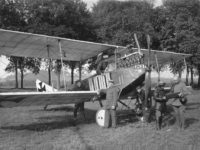The Albatros B.II was a further development of the predecessor model B.I, which should serve the claims of the military leadership to a reconnaissance aircraft. In addition to the German air force, the aircraft was also used in Austria-Hungary and the Ottoman Empire.
Development and construction:
From 1914, the company Albatros Flugzeugwerke already began with the further development of the type B.I aircraft. The B.II should serve as reconnaissance aircraft in the air force, but the observer was moved from the rear to the front post and got a better overall viewing position.
During production, a modified version was developed, the B.IIa version. This had a more armored cell to protect against fire and had installed Mercedes D II or Argus As II engines with 120hp.
Captured Albatros B.II aircraft were also used by Russian designers to develop the Lebedev-11 and Lebedev-12 aircraft.
Use in the First World War:
Like the B.I, the B.II was also used as a reconnaissance plane during the First World War. By default, the aircraft were unarmed, but sporadically, machine guns were mounted to defend against attacks.
With the introduction of Class C aircraft, the Albatros aircraft were gradually replaced and served as training aircraft until the end of the war.
Technical specifications:
| Designation: | Albatros B.II |
| Country: | German Empire |
| Typ: | Reconnaissance plane |
| Length: | 7,65 meters |
| Span: | 12,8 meters |
| Height: | 3,15 meters |
| Mass: | 720kg empty |
| Crew: | Max. 2 |
| Engine: | Water-cooled 6-cylinder in-line engine Mercedes D-I 105PS starting power |
| Maximum speed: | 110 km/h |
| Reach: | 400 kilometers |
| Armament: | Isolated 1 machine gun |
You can find the right literature here:
Fokker Dr I Aces of World War 1 (Aircraft of the Aces)
Undoubtedly the most famous fighter type to see service on either side during World War 1, the Fokker Dr I was a revelation when it entered service on the western front in 1917. Manfred von Richthofens JG 1 circus was the first Jasta to completely re-equip with the new fighter, and in the skilled hands of its numerous aces the Dr I proved a formidable opponent. The Dr I remained in service on the Western Front until replaced by the superior Fokker D VII in May 1918. Just weeks prior to that, however, Germanys leading ace, the great Red Baron, had been killed at the controls of a Dr I.
Friedrichshafen Aircraft of WWI: A Centennial Perspective on Great War Airplanes (Great War Aviation) (Volume 21)

Friedrichshafen Aircraft of WWI: A Centennial Perspective on Great War Airplanes (Great War Aviation) (Volume 21) Paperback – February 16, 2016
This book describes and illustrates the development of Friedrichshafen aircraft of WWI with text, 540 photos, 18 in color, 37 color profiles, production quantities and serial numbers of aircraft, and aircraft dimensions and performance specifications. In addition, there are 26 official SVK drawings and 11 aircraft are illustrated in scale drawings to 1/48 (4) or 1/72 (7) scales. The book has 312 pages and is of interest to aviation historians, enthusiasts, and modelers alike.
German and Austro-Hungarian Aircraft Manufacturers 1908-1918
Much has been written about the British aircraft of the First World War, but little has surfaced about the aircraft of the Axis powers, Germany and Austria. Here, Terry C. Treadwell tells the story of the aircraft from companies such as Fokker, builder of the famous triplane, as fl own by Baron von Richthofen's Flying Circus, AEG, Albatros, Junkers and Hansa. From reconnaissance aircraft to state-of-the-art bombers that could reach London, this is the definitive guide to aircraft of the Axis powers during the First World War. The aircraft are explained in detail and a history of each company is provided, making this an excellent source book for aircraft enthusiasts, model makers and those interested in the air war over the trenches of France and Belgium, as well as further afield in the Italian campaign.
The Zeppelin in Combat: A History of the German Naval Airship Division
The standard reference now revised and expanded. Dr. Robinson has opened up his vast photo archives to enhance this new edition of his classic work. Much of the new photographic material is published here for the first time.
This post is also available in:
 Deutsch (German)
Deutsch (German)  Français (French)
Français (French)  Italiano (Italian)
Italiano (Italian)  简体中文 (Chinese (Simplified))
简体中文 (Chinese (Simplified))  Русский (Russian)
Русский (Russian)  Español (Spanish)
Español (Spanish)  العربية (Arabic)
العربية (Arabic)



















